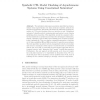Free Online Productivity Tools
i2Speak
i2Symbol
i2OCR
iTex2Img
iWeb2Print
iWeb2Shot
i2Type
iPdf2Split
iPdf2Merge
i2Bopomofo
i2Arabic
i2Style
i2Image
i2PDF
iLatex2Rtf
Sci2ools
109
Voted
ATVA
2009
Springer
2009
Springer
Symbolic CTL Model Checking of Asynchronous Systems Using Constrained Saturation
Abstract. The saturation state-space generation algorithm has demonstrated clear improvements over state-of-the-art symbolic methods for asynchronous systems. This work is motivated by efficiently applying saturation to CTL model checking. First, we introduce a new “constrained saturation” algorithm which constrains state exploration to a set of states satisfying given properties. This algorithm avoids the expensive afterthe-fact intersection operations and retains the advantages of saturation, namely, exploiting event locality and benefiting from recursive local fixpoint computations. Then, we employ constrained saturation to build the set of states satisfying EU and EG properties for asynchronous systems. The new algorithm can achieve orders-of-magnitude reduction in runtime and memory consumption with respect to methods based on breath-first search, and even with a previously-proposed hybrid approach that alternates between “safe” saturation and “unsafe” breadth-firs...
Related Content
| Added | 26 May 2010 |
| Updated | 26 May 2010 |
| Type | Conference |
| Year | 2009 |
| Where | ATVA |
| Authors | Yang Zhao, Gianfranco Ciardo |
Comments (0)

